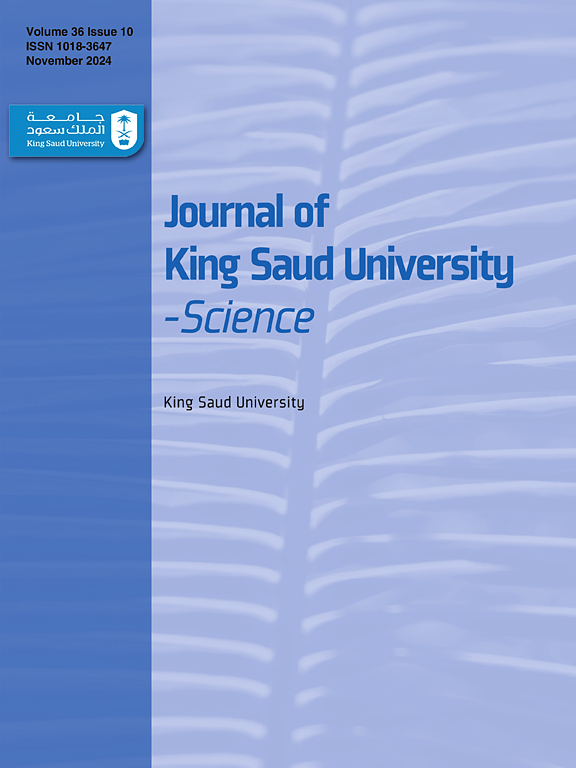Interbreed differences in iron concentration in cattle organs and tissues
IF 3.6
3区 综合性期刊
Q1 MULTIDISCIPLINARY SCIENCES
引用次数: 0
Abstract
Objective
This study aimed to evaluate the differences in iron accumulation in organs and tissues of cattle bred in ecologically robust zones of Western Siberia.
Methods
The authors presented 486 samples of the muscle, hair, heart, liver, kidneys, and spleen from three breeds of bulls. The authors examined 84 Black Pied, Hereford, and Holstein bulls aged 16–18 months. The Black Pied bulls were bred in the Ubinsky district of the Novosibirsk region, Russia, the Hereford bulls were bred in the Maslyaninsky district of the Novosibirsk region, and the Holstein bulls were bred in the Promyshlensky district of the Kemerovo region, Russia. The authors studied the chemical composition of organs and muscle tissue using atomic absorption spectrometry with flame and electrothermal atomization using an MGA-1000 spectrometer.
Results
The median iron concentrations in the muscle, hair, heart, liver, kidneys, and spleen were 16.5–49.1, 22.3–130, 42–70, 56.5–68.3, 39.3–52.2, and 252.2–472 mg/kg, respectively. The authors recorded the highest iron concentration in the spleen, where its concentration was significantly higher than in other organs, regardless of the breed.
Conclusion
The breed significantly affected the iron content in muscle tissue, heart, kidneys, hair, and spleen. The iron concentrations in muscle tissue, heart, and spleen were higher in Black Pied cattle, and iron concentrations in hair were lower in Holstein and Hereford cattle. Multivariate statistical methods showed high phenotypic similarity in iron accumulation in organs and tissues between Hereford and Holstein cattle. Animals’ breed and age should be considered when developing regional standards for iron content.
牛器官和组织中铁浓度的杂交差异
目的研究西伯利亚西部生态健壮区牛各器官和组织铁积累的差异。方法收集了3个品种公牛的肌肉、毛发、心脏、肝脏、肾脏和脾脏的486份标本。作者研究了84头16-18个月大的黑斑、赫里福德和荷斯坦公牛。黑花斑牛是在俄罗斯新西伯利亚地区的乌宾斯基地区繁殖的,赫里福德公牛是在新西伯利亚地区的马斯莱亚尼斯基地区繁殖的,荷尔斯坦公牛是在俄罗斯克麦罗沃地区的普罗米什连斯基地区繁殖的。本文采用火焰原子吸收光谱法和MGA-1000谱仪电热雾化法研究了人体器官和肌肉组织的化学成分。结果大鼠肌肉、毛发、心脏、肝脏、肾脏、脾脏中位铁浓度分别为16.5 ~ 49.1、22.3 ~ 130、42 ~ 70、56.5 ~ 68.3、39.3 ~ 52.2、252.2 ~ 472 mg/kg。作者记录了脾脏的铁浓度最高,无论品种如何,脾脏的铁浓度都明显高于其他器官。结论该品种显著影响了肌肉组织、心脏、肾脏、毛发和脾脏中的铁含量。黑斑牛的肌肉组织、心脏和脾脏铁含量较高,荷斯坦牛和赫里福德牛的毛发铁含量较低。多元统计方法显示,赫里福德牛和荷斯坦牛在器官和组织中铁积累的表型相似性很高。在制定地区铁含量标准时,应考虑动物的品种和年龄。
本文章由计算机程序翻译,如有差异,请以英文原文为准。
求助全文
约1分钟内获得全文
求助全文
来源期刊

Journal of King Saud University - Science
Multidisciplinary-Multidisciplinary
CiteScore
7.20
自引率
2.60%
发文量
642
审稿时长
49 days
期刊介绍:
Journal of King Saud University – Science is an official refereed publication of King Saud University and the publishing services is provided by Elsevier. It publishes peer-reviewed research articles in the fields of physics, astronomy, mathematics, statistics, chemistry, biochemistry, earth sciences, life and environmental sciences on the basis of scientific originality and interdisciplinary interest. It is devoted primarily to research papers but short communications, reviews and book reviews are also included. The editorial board and associated editors, composed of prominent scientists from around the world, are representative of the disciplines covered by the journal.
 求助内容:
求助内容: 应助结果提醒方式:
应助结果提醒方式:


